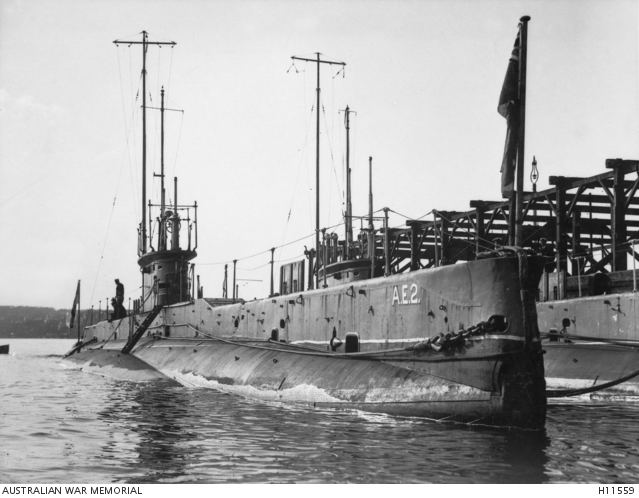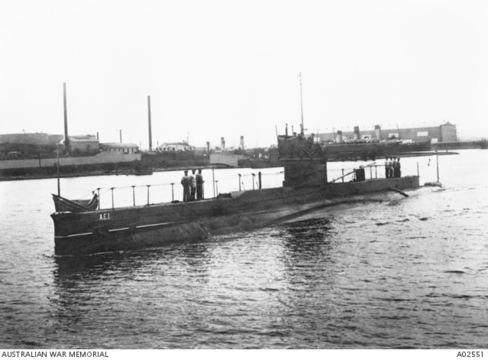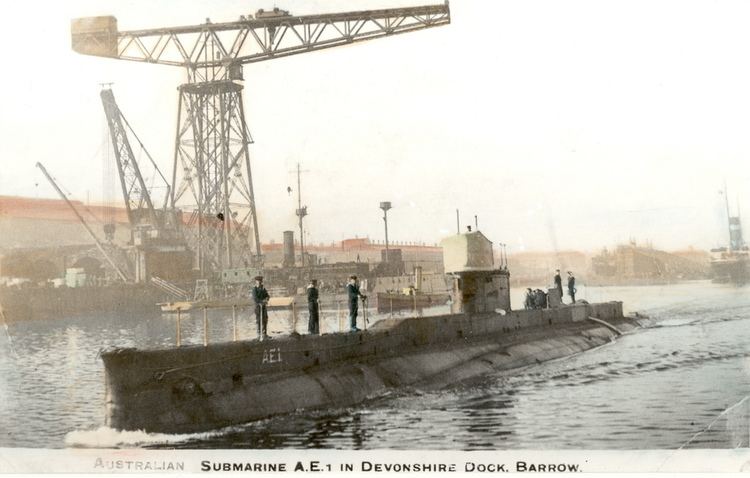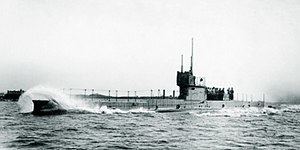Laid down 14 November 1911 Launched 22 May 1913 Test depth 61 m Beam 6.86 m | Commissioned 28 February 1914 Construction started 14 November 1911 Length 55 m Draft 3.81 m Builder Vickers-Armstrongs | |
 | ||
Honours andawards Battle honoursRabaul 1914 Fate Lost at sea, 14 September 1914 Notes Location of sinking unknown | ||
HMAS AE1 (originally known as just AE1) was an E-class submarine of the Royal Australian Navy (RAN). She was the first submarine to serve in the RAN, and was lost at sea with all hands near East New Britain, Papua New Guinea, on 14 September 1914, after less than seven months in service. The wreck of the submarine has never been found, despite several searches.
Contents

Design and construction

The E-class was a version of the preceding D-class submarine enlarged to accommodate an additional pair of broadside torpedo tubes. AE1 was 181 feet (55.2 m) long overall, had a beam of 22 feet 6 inches (6.9 m) and a draught of 12 feet 6 inches (3.8 m). She displaced 750 long tons (760 t) on the surface and 810 long tons (820 t) submerged. The E-class boats had a designed diving depth of 100 feet (30.5 m), but the addition of watertight bulkheads strengthened the hull and increased the actual diving depth to 200 feet (61.0 m). The complement consisted of 34 officers and ratings.

The boat had two propellers, each of which was driven by an eight-cylinder, 800-brake-horsepower (600 kW) diesel engine as well as a 420-brake-horsepower (313 kW) electric motor. This arrangement gave the E-class submarines a maximum speed of 15 knots (28 km/h; 17 mph) while surfaced and 10 knots (19 km/h; 12 mph) when submerged. They carried approximately 40 long tons (41 t) of fuel oil, which provided a range of 3,000 nautical miles (5,600 km; 3,500 mi) at 10 knots (19 km/h; 12 mph) while on the surface and 65 nmi (120 km; 75 mi) at 5 knots (9.3 km/h; 5.8 mph) while submerged. AE1 had four 18-inch torpedo tubes, one each in the bow and stern, plus two on the broadside, one firing to port and the other to starboard. The boat carried one spare torpedo for each tube. No guns were fitted.

AE1 was laid down by Vickers Armstrong at Barrow-in-Furness, England, on 14 November 1911, launched on 22 May 1913 and commissioned into the RAN on 28 February 1914. After commissioning, AE1, accompanied by AE2, the other of the RAN's first two submarines, reached Sydney from England on 24 May 1914. Officers for the submarines were Royal Navy (RN) personnel, while the ratings were a mix of sailors drawn from the RN and RAN.
Deployment and loss

At the outbreak of World War I, AE1, commanded by Lieutenant Commander Thomas Besant, was sent to capture German New Guinea as part of the Australian Naval and Military Expeditionary Force. Along with AE2, she took part in the operations leading to the occupation of the German territory, including the surrender of Rabaul on 13 September 1914. The submarine's involvement was recognised in 2010, following an overhaul of the RAN battle honours system, with the retroactive awarding of the honour "Rabaul 1914".

At 07:00 on 14 September, AE1 departed Blanche Bay, Rabaul, to patrol off Cape Gazelle with HMAS Parramatta. When she had not returned by 20:00, several ships were dispatched to search for her. No trace of the submarine was ever found, and she was listed as lost with all hands. It is probable that she was wrecked on a reef or other submerged object. The disappearance was Australia's first major loss of World War I.
Searches
Beyond the initial search immediately after the submarine's disappearance, there were no concentrated efforts to locate the wreck of AE1 until the 1970s, when John Foster, a RAN officer working in Port Moresby, became interested in the story. After researching wartime records, Foster convinced the RAN to deploy the survey ship HMAS Flinders in 1976. Flinders found one potential sonar contact, but did not have a sophisticated enough side-scan sonar to make a determination either way. During a deployment to Papua New Guinea in 1978, Flinders conducted several ad-hoc searches, again with no useful result. In 1990, while sailing between New Britain and New Ireland, Jacques Cousteau diverted his ship, Calypso to investigate the potential contact found in 1976. His original plan was to investigate up close with a submersible, but mechanical issues prevented it, and Calypso instead performed a magnetometer search of the area, finding no wrecks.
Foster had continued archive research into AE1's disappearance, supplemented with visits to Rabaul and nearby islands to see if references to the submarine appeared in any community's oral histories. By 2002, he was focused on the waters off Mioko Island in the Duke of York Islands group: a priest from a Catholic mission had claimed that members of the community had spotted a wrecked submarine on Wirian Reef while diving for shells. Attempts to dive the reported site of the wreck in 2002 and early 2003 were unsuccessful: the former called off due to high shark presence, the latter expedition also hampered by shark activity, but finding no wreck at the claimed location. A third expedition in November 2003, supported by the Maritime Museum of Western Australia and the Australian Broadcasting Corporation, conducted searches off Mioko and nearby islands, again with no success. Further oral evidence supporting the wreck of AE1 being off Mioko was learned during one of the 2003 expeditions: Foster discovered that the Tolai people had a legend of a "devil fish" appearing offshore on the day that AE1 disappeared.
In February 2007, a new effort to locate the submarine was mounted by the RAN, when the survey ships Benalla and Shepparton attempted to locate the submarine off East New Britain. Benalla located an object on Wirian Reef of the appropriate dimensions using sonar on 1 March, but was unable to verify the nature of the object due to a damaged magnetometer. The minehunter HMAS Yarra was sent to investigate the object further in late 2007. Sonar and remotely-operated vehicle (ROV) imagery of the object revealed shape and dimensions similar to the submarine, but subsequent analysis by the Defence Science and Technology Organisation identified the object as a rock formation.
Foster organised another search in May 2009, partially funded by Channel Seven's Sunday Night, based on claims by a Rabaul-based salvage diver that he had seen the wreck in Simpson Harbour back in 1971, in proximity to the wreck of the Japanese merchant ship Keifuku Maru. Diver searches of the site specified by the salvager failed to find either wreck. A followup search later that year by the Western Australian Maritime Museum found that Keifuku Maru had been buried under 30 metres (98 ft) of rock during the 1994 Rabaul caldera eruption, but found no evidence of AE1, buried or otherwise. During early 2012, the minehunter HMAS Gascoyne and the survey ship HMNZS Resolution detected a potential wrecked submarine in Simpson Harbour. Although initially suspected to be AE1, the wreck was determined to be a World War II-era Japanese midget submarine. Resolution later conducted sonar surveys of areas AE1 may have been lost in, with no wrecks found.
Between 6 and 9 September 2014, Yarra conducted searches around the Duke of York Islands, prior to a memorial service for the centenary of the submarine's disappearance. Although numerous sonar "contacts of interest" were made during the search, including one which was singled out for further investigation, all were found to be natural terrain.
In September 2015, plans for a new search were announced by Find AE1 Limited. The search, to occur off Mioko Island in November, would be conducted by a mining survey ship towing a multi-beam echo sounder array. If the November search is unsuccessful, Find AE1 Limited plans to petition the Australian government to bring in the search equipment used during the search for Malaysia Airlines Flight 370.
Several factors have been identified as increasing the difficulty of finding AE1. The volcanic nature of the region has resulted in a rugged and highly variable underwater topography, with a high frequency of wreck-like acoustic anomalies. Much of the region is deep water, limiting the number of techniques and tools that can be used to locate and verify shipwrecks. Volcanic activity can also disrupt the local magnetic field, affecting the operations of magnetometers. Eruptions and underwater earthquakes cause the underwater landscape to change, and have the potential to break up or bury a shipwreck. Due to heavy military activity around New Guinea during World War II, along with the disposal of ships in later years, there are large numbers of other shipwrecks (both located and unknown) in any potential search area.
Memorials
In 1933, a stained-glass window commemorating the losses of AE1 and AE2 was added to the naval chapel at Garden Island in Sydney.
In September 2015, a floating sculpture to commemorate AE1 was unveiled outside the Australian National Maritime Museum. The sculpture takes the form of a stainless steel wreath, 6 metres (20 ft) in diameter, which projects patterns of light onto the water at night.
In 2008 a memorial plague was dedicated to HMAS AE1 at the Tasmanian Seafarers' Memorial at Triabunna on the east coast of Tasmania, commemorating the loss of L.S. Cyril Lefroy Baker RAN, Telegraphist, the first Tasmanian killed in his country's service in World War I.
